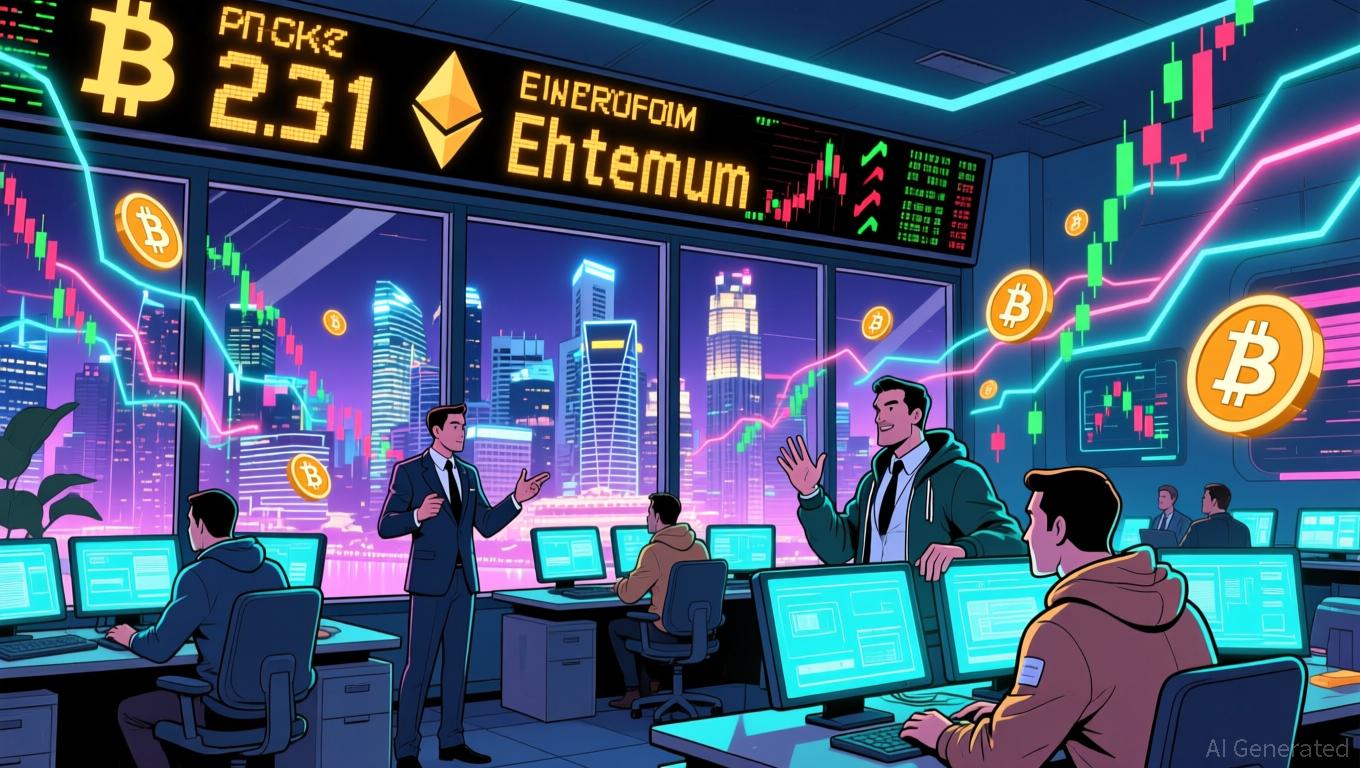Bitcoin News Update: Exchanges Compete With Crypto Perpetuals to Regain Importance Among Institutions
- Stock exchanges like SGX and Qatar bourses face pressure to adopt crypto perpetual futures (perps) to retain institutional relevance amid $187B+ global daily trading volumes. - SGX's Nov. 24 Bitcoin/Ethereum perps launch reflects traditional finance's integration with crypto, as $57.7B+ daily Bitcoin perp volumes outpace traditional offerings. - Gulf markets show mixed adaptation: Qatar's Ooredoo QPSC secondary offering contrasts with UAE's $5B+ in 2024 secondary sales, while China's property crisis expo
Stock Exchanges Face Transformation Amid Surge in Perpetual Futures
The rapid growth of equity perpetual futures is pushing stock exchanges worldwide to a critical juncture. Leading platforms such as the Singapore Exchange (SGX) and Qatar's exchanges are under pressure to evolve or risk falling behind. SGX’s recent introduction of Bitcoin and Ethereum perpetual futures—among the first of their kind in Asia—highlights the growing influence of crypto-based products, which are increasingly outpacing conventional financial instruments.
Globally, perpetual contracts now account for over $187 billion in daily trading volume, prompting exchanges to swiftly incorporate these offerings to maintain their appeal to institutional investors. The SGX’s move, which began on November 24, is part of a broader initiative to merge traditional finance with the digital asset ecosystem. Perpetual futures, which have no set expiration and rely on funding rates to align with spot prices, have become a dominant force in crypto trading since late 2020. For example, Bitcoin perpetuals alone averaged $57.7 billion in daily trades in early 2024. This strategy is a key element of SGX’s $5 billion Equity Market Development Programme, designed to rejuvenate Singapore’s exchange and signal that regulated crypto derivatives are now accessible to major investors.

The timing of these developments is notable: Bitcoin recently experienced a sharp decline, erasing its 2025 gains and dropping below $90,000 after previously reaching a high of $126,251. Despite this downturn, Hassan Ahmed, head of Coinbase Singapore, believes that launching perpetual futures during a market correction encourages institutions to view them as tools for managing risk, rather than simply speculative assets.
Traditional Markets Respond to Change
Other exchanges are also feeling the need to adapt. In Qatar, a $552 million secondary share sale by Ooredoo QPSC marked the most significant equity market activity in years. Analysts at Citigroup suggest this could pave the way for more listings as Qatar seeks to expand market participation. Regulatory changes—such as permitting short-selling and offering incentives for companies to relocate—are intended to enhance liquidity, though ongoing progress will depend on continued offerings and the emergence of local market leaders. Meanwhile, the UAE has already generated nearly $5 billion from secondary share sales this year, underscoring the urgency for other exchanges to innovate.
Risks and Challenges in Evolving Markets
However, the path to modernization carries risks. Private equity firms like Gaw Capital Partners, which recently secured an 18-month loan extension for a Shanghai property-backed asset (with the loan reduced to $108 million), illustrate the vulnerability of traditional investment approaches amid China’s real estate turmoil. Additionally, high-profile setbacks—such as Platinum Equity’s $1.4 billion loss on United Site Services—highlight the dangers of excessive reliance on leveraged buyouts. These examples reinforce a broader trend: as financial markets transform, inflexible business models are increasingly at risk.
The Future of Perpetual Futures
The influence of equity perpetuals is likely to expand beyond the crypto sector. Architect Financial Technologies has recently launched perpetual futures for mainstream assets like foreign currencies and stock indices, hinting at a significant shift in market dynamics. Crypto exchange Hyperliquid is also broadening its offerings, introducing new incentives for perpetual markets that include tokenized equities and pre-IPO stocks. For stock exchanges, the imperative is clear: ongoing innovation is essential for survival.
As Hassan Ahmed observed, “The key benefit of launching during a downturn is that institutions get to see the value of perps as genuine risk-management tools rather than speculative instruments.”
In an environment where Bitcoin’s price swings rival those of major stock indices and regulatory frameworks are in flux, the ability to adapt may prove to be the most valuable asset for exchanges moving forward.
Disclaimer: The content of this article solely reflects the author's opinion and does not represent the platform in any capacity. This article is not intended to serve as a reference for making investment decisions.
You may also like
COAI Experiences Steep Price Drop: Opportunity for Contrarian Investors or Red Flag for Junior Gold Mining Stocks?
- COAI refers to both ChainOpera AI and junior gold miners' index, with this analysis focusing on the latter's market dynamics. - Junior gold miners (GDXJ ETF) fell 27% in six months amid dollar strength, inflation fears, and overbought conditions after a 128.8% rally. - Technical indicators show bearish signals: broken trend channels, negative volume balance, and RSI divergence, though long-term bull trends persist. - GDXJ's 163.9% surge outpaced gold bullion gains, creating valuation gaps, while ChainOpe

Silver Soars Amid Ideal Conditions of Policy Shifts and Tightening Supply
- Silver surged to $52.37/oz as Fed rate cut expectations (80% probability) and falling U.S. Treasury yields boosted demand for non-yielding assets. - China's record 660-ton silver exports and 2015-low Shanghai warehouse inventories intensified global supply constraints, pushing the market into backwardation. - Geopolitical risks (Ukraine war) and potential U.S. silver tariffs added volatility, while improved U.S.-China relations eased short-term trade concerns. - Prices face critical $52.50 resistance; Fe
XRP News Today: As XRP Declines, Retail Investors Turn to GeeFi's Practical Uses
- GeeFi's presale hits 80% of Phase 1 goal with $350K raised, targeting 3,900% price growth as XRP declines 20% monthly. - GEE's utility-driven features like crypto cards, multi-chain support, and 55% staking returns contrast with XRP's institutional dependency and shrinking retail base. - Deflationary tokenomics and 5% referral bonuses drive FOMO, positioning GeeFi as a 2026 crypto disruptor amid XRP's regulatory and adoption challenges.

Sloppy implementation derails MegaETH's billion-dollar stablecoin aspirations
- MegaETH abandoned its $1B USDm stablecoin pre-deposit plan after technical failures disrupted the launch, freezing deposits at $500M and issuing refunds. - A misconfigured Safe multisig transaction allowed early deposits, causing $400M inflows before the team scrapped the target, citing "sloppy execution" and operational misalignment. - Critics highlighted governance flaws, uneven access (79 wallets >$1M vs. 2,643 <$5K deposits), and 259 duplicate addresses, raising concerns about transparency and bot ac
